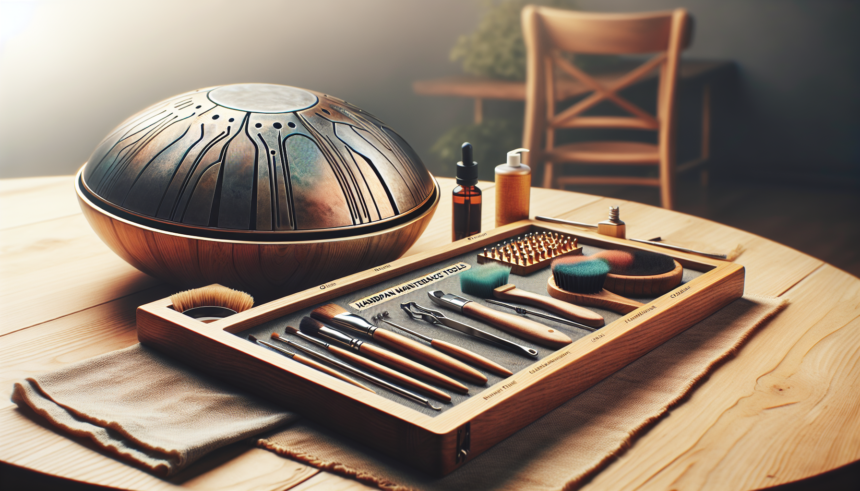The handpan is a unique and melodic instrument that has captivated musicians and listeners alike since its inception. Its ethereal tones and harmonious vibrations make it a cherished possession for many. However, like all musical instruments, the handpan requires proper care and maintenance to ensure it remains in top shape. This article will guide you through the essential handpan maintenance tools and techniques to keep your instrument pristine and melodious.
Understanding the Basics of Handpan Maintenance
Before diving into the specific tools required for handpan maintenance, it is crucial to understand why maintenance is necessary. The handpan consists of two steel sheets that are carefully hammered and tuned to produce distinct notes. Over time, exposure to environmental elements, moisture, and physical handling can affect the handpan’s tuning and overall condition.
Regular maintenance not only keeps your handpan sounding its best but also extends its lifespan. It is always recommended to handle your instrument with clean hands, store it in a safe and controlled environment, and carry out periodic cleaning and inspections.
Essential Handpan Maintenance Tools
Maintaining your handpan doesn’t require a vast array of tools, but a few specialized items can make a significant difference. Here are the critical tools and substances you’ll need:
1. Microfiber Cloth
A microfiber cloth is a fundamental tool for cleaning your handpan. It is soft, non-abrasive, and perfect for wiping down the surface of the instrument. Regularly using a microfiber cloth helps remove dust, oils, and fingerprints, keeping the handpan clean and visually appealing.
2. Cleaning Solution
A mild cleaning solution specifically designed for steel instruments is ideal for maintaining the handpan’s surface. Avoid harsh chemicals, as they can damage the delicate finish. A solution of distilled water and a few drops of mild dish soap works well. Ensure to rinse thoroughly with distilled water to remove any soapy residue.
3. Oil for Rust Prevention
Handpans are typically made of nitrided steel, which offers some resistance to rust. However, regular exposure to moisture and oils from your hands can still cause corrosion over time. Applying a light oil such as Ballistol or Phoenix Handpan Oil helps prevent rust and keeps the instrument’s surface in top condition. Use sparingly and wipe off any excess with a microfiber cloth.
4. Tuning Tools
The tuning of a handpan is a specialized skill that usually requires professional expertise. However, minor adjustments can sometimes be made by experienced players using tuning tools. These tools include small hammers, tuning rings, and electronic tuners. It is crucial to approach tuning with caution, as improper handling can lead to irreversible damage.
5. Protective Case
A high-quality protective case is essential for storing and transporting your handpan. Look for cases that offer sturdy protection, padding, and a secure fit. This investment will pay off by safeguarding your instrument from physical damage and the elements when not in use.
Step-by-Step Maintenance Routine
Following a consistent maintenance routine is crucial for the longevity and performance of your handpan. Here is a step-by-step guide to help you keep your instrument in optimal condition:
1. Regular Cleaning
Begin by using a dry microfiber cloth to wipe the surface of your handpan, removing any dust and fingerprints. If needed, lightly dampen the cloth with a mild cleaning solution and gently clean the surface. Ensure all soap residues are removed by wiping with a cloth dampened with distilled water.
2. Oil Application
Apply a thin layer of Ballistol or your chosen oil using a clean microfiber cloth. Spread the oil evenly across the entire surface of the handpan. This process helps protect against rust and keeps the steel hydrated. After applying the oil, wipe away any excess to prevent a sticky buildup.
3. Inspect for Damage
Regularly inspect your handpan for signs of damage, such as dents, scratches, or rust spots. Addressing these issues early can prevent more significant problems down the line. For minor scratches or rust spots, gently rubbing with a fine steel wool pad followed by reapplying oil can often resolve the issue.
4. Proper Storage
Always store your handpan in a controlled environment, free from extreme temperatures and humidity. Use a protective case to safeguard the instrument from physical damage and environmental elements when not in use. Avoid leaving the handpan exposed for extended periods, especially in humid or damp locations.
5. Professional Tuning
While minor tuning adjustments can be performed by experienced players, it is advisable to seek professional tuning services regularly. A well-tuned handpan produces the most beautiful and harmonious sounds, and professionals have the expertise and tools to ensure precise tuning.
Conclusion
The handpan is a remarkable instrument that brings joy and serenity to both players and listeners. Keeping it in top shape requires consistent care and the right tools. By incorporating regular cleaning, rust prevention, damage inspection, proper storage, and professional tuning into your maintenance routine, you can ensure your handpan continues to produce its unique, captivating melodies for years to come.
Investing time and effort into maintaining your handpan not only preserves its aesthetic and acoustic qualities but also deepens your connection with the instrument. Enjoy the journey of handpan maintenance and the rewarding experience of playing an instrument that is always in its best form.
FAQs
Q1: How often should I clean my handpan?
A1: It is recommended to clean your handpan after each use to remove oils and fingerprints. A more thorough cleaning with a mild solution and oil application can be done every few weeks or as needed based on your playing frequency.
Q2: Can I tune my handpan myself?
A2: Minor tuning adjustments can be made by experienced players using specialized tools. However, for precise tuning and avoid potential damage, it is advisable to seek professional tuning services regularly.
Q3: What type of oil is best for rust prevention on a handpan?
A3: Light oils such as Ballistol or Phoenix Handpan Oil are ideal for rust prevention. They are specifically designed for steel instruments and help protect the handpan’s surface from moisture and corrosion.
Q4: How should I store my handpan when not in use?
A4: Store your handpan in a controlled environment with a stable temperature and low humidity. Use a protective case to prevent physical damage and exposure to the elements. Avoid leaving the instrument exposed for extended periods.
Q5: What should I do if I notice rust spots on my handpan?
A5: If you notice rust spots on your handpan, gently rub them with a fine steel wool pad to remove the rust. Follow this by applying a thin layer of oil to the affected area to protect against future corrosion.





